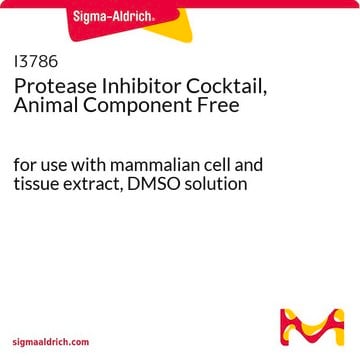P8215
Protease Inhibitor Cocktail
DMSO solution, for the inhibition of serine, cysteine, aspartic and metalloproteases, for use with fungal and yeast extracts, DMSO solution
Synonyme(s) :
Protease Inhibitor Mix, Protease inhibitor
About This Item
Produits recommandés
product name
Cocktail d'inhibiteurs de protéases, for use with fungal and yeast extracts, DMSO solution
Niveau de qualité
Forme
DMSO solution
Température de stockage
−20°C
Vous recherchez des produits similaires ? Visite Guide de comparaison des produits
Description générale
Spécificité
Application
- FA buffer to wash spheroplasts to obtain an average DNA fragment size for chromatin immunoprecipitation (chip)
- potassium phosphate buffer (pbs) to digest chitin
- extraction buffer for grinding powdered mycelia for co-immunoprecipitation analysis
Caractéristiques et avantages
- Broad specificity: inhibits a wide range of proteases, providing comprehensive protection to fungal and yeast extracts.
- Tested on Saccharomyces cerevisiae cells: the cocktail has been optimized for use on this commonly studied yeast strain.
- Convenient packaging: available in a 1 or 5 mL glass bottle for easy handling and storage.
- Ready-to-use solution: the cocktail is supplied in DMSO solution for immediate use in protease inhibition assays.
- Effective inhibition: each component in the cocktail has been carefully selected for its specific inhibitory properties, ensuring reliable and consistent results.
Composants
E-64, 1.4 mM
Pepstatin A, 2.2 mM
1,10-Phenanthroline, 500 mM
Autres remarques
Quantité
Forme physique
Produit(s) apparenté(s)
Mention d'avertissement
Warning
Mentions de danger
Conseils de prudence
Classification des risques
Acute Tox. 4 Oral - Aquatic Acute 1 - Aquatic Chronic 1 - Eye Irrit. 2 - Skin Irrit. 2
Code de la classe de stockage
10 - Combustible liquids
Classe de danger pour l'eau (WGK)
WGK 3
Point d'éclair (°F)
188.6 °F
Point d'éclair (°C)
87 °C
Certificats d'analyse (COA)
Recherchez un Certificats d'analyse (COA) en saisissant le numéro de lot du produit. Les numéros de lot figurent sur l'étiquette du produit après les mots "Lot" ou "Batch".
Déjà en possession de ce produit ?
Retrouvez la documentation relative aux produits que vous avez récemment achetés dans la Bibliothèque de documents.
Les clients ont également consulté
Contenu apparenté
Select different protease inhibitor types based on your needs to prevent protein degradation during isolation and characterization and safeguard proteins in sample prep.
Select different protease inhibitor types based on your needs to prevent protein degradation during isolation and characterization and safeguard proteins in sample prep.
Select different protease inhibitor types based on your needs to prevent protein degradation during isolation and characterization and safeguard proteins in sample prep.
Select different protease inhibitor types based on your needs to prevent protein degradation during isolation and characterization and safeguard proteins in sample prep.
Notre équipe de scientifiques dispose d'une expérience dans tous les secteurs de la recherche, notamment en sciences de la vie, science des matériaux, synthèse chimique, chromatographie, analyse et dans de nombreux autres domaines..
Contacter notre Service technique












